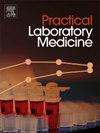Comparative validation of low-density lipoprotein cholesterol estimation formulas in older Georgian adults
IF 1.3
Q3 MEDICAL LABORATORY TECHNOLOGY
引用次数: 0
Abstract
Introduction
Low-density lipoprotein cholesterol (LDL-C) is a critical marker for cardiovascular risk assessment. Although direct measurement offers high accuracy, it is often cost-prohibitive and impractical for routine use in low- and middle-income countries. Multiple formulas, including those by Friedewald, de Cordova, and Chen, have been proposed to estimate LDL-C, though their accuracy varies across populations. This study evaluated the performance of eight LDL-C estimation formulas against direct measurement in a predominantly older adult Georgian cohort.
Materials and methods
We retrospectively analyzed lipid profiles from 500 adults with complete panels, stratified by triglyceride (TG) levels, high-density lipoprotein cholesterol (HDL-C), total cholesterol (TC), and age. LDL-C was estimated using eight formulas and compared with direct LDL-C assays. The study adhered to the Helsinki Declaration and was approved by the Bioethics International Committee of Petre Shotadze Tbilisi Medical Academy.
Results
Substantial variability was observed across formulas. Friedewald and Chen showed minimal underestimation, aligning well with direct measurements, particularly at moderate TG levels. The de Cordova formula maintained stable accuracy across TG strata, including borderline hypertriglyceridaemia. The Ahmadi formula, originally developed for mmol/L, produced significant overestimation in mg/dL units and was excluded from threshold-based analyses. Sensitivity testing using CLIA's dual total allowable error (TEa) thresholds (±12 % or 12 mg/dL) improved agreement for all formulas, especially at low LDL-C levels.
Conclusions
Friedewald and de Cordova offer reliable, cost-effective LDL-C estimates for older adults. Formula selection should account for TG levels, demographics, and analytical context. Broader validation in diverse cohorts is needed to enhance generalizability.
格鲁吉亚老年人低密度脂蛋白胆固醇估算公式的比较验证
低密度脂蛋白胆固醇(LDL-C)是心血管风险评估的重要指标。虽然直接测量具有很高的准确性,但在低收入和中等收入国家常规使用往往成本过高且不切实际。包括Friedewald、de Cordova和Chen的公式在内的多种公式已经被提出用于估计LDL-C,尽管它们的准确性因人群而异。本研究评估了8种LDL-C估计公式与直接测量在格鲁吉亚主要老年人队列中的表现。材料和方法我们回顾性分析了500名成年人的脂质谱,并根据甘油三酯(TG)水平、高密度脂蛋白胆固醇(HDL-C)、总胆固醇(TC)和年龄进行分层。使用8个公式估计LDL-C,并与直接LDL-C测定法进行比较。这项研究遵循《赫尔辛基宣言》,并得到第比利斯彼得·舒塔泽医学院生物伦理国际委员会的批准。结果各配方间存在显著差异。Friedewald和Chen显示了最小的低估,与直接测量结果很好地吻合,特别是在中等TG水平下。de Cordova公式在TG各层(包括交界型高甘油三酯血症)中保持稳定的准确性。最初为mmol/L开发的Ahmadi公式在mg/dL单位上产生了显著的高估,因此被排除在基于阈值的分析之外。使用CLIA的双总允许误差(TEa)阈值(±12%或12 mg/dL)的敏感性测试提高了所有配方的一致性,特别是在低LDL-C水平下。结论friedewald和de Cordova为老年人提供了可靠的、具有成本效益的LDL-C估计。公式选择应考虑到TG水平,人口统计和分析背景。需要在不同的人群中进行更广泛的验证,以增强普遍性。
本文章由计算机程序翻译,如有差异,请以英文原文为准。
求助全文
约1分钟内获得全文
求助全文
来源期刊

Practical Laboratory Medicine
Health Professions-Radiological and Ultrasound Technology
CiteScore
3.50
自引率
0.00%
发文量
40
审稿时长
7 weeks
期刊介绍:
Practical Laboratory Medicine is a high-quality, peer-reviewed, international open-access journal publishing original research, new methods and critical evaluations, case reports and short papers in the fields of clinical chemistry and laboratory medicine. The objective of the journal is to provide practical information of immediate relevance to workers in clinical laboratories. The primary scope of the journal covers clinical chemistry, hematology, molecular biology and genetics relevant to laboratory medicine, microbiology, immunology, therapeutic drug monitoring and toxicology, laboratory management and informatics. We welcome papers which describe critical evaluations of biomarkers and their role in the diagnosis and treatment of clinically significant disease, validation of commercial and in-house IVD methods, method comparisons, interference reports, the development of new reagents and reference materials, reference range studies and regulatory compliance reports. Manuscripts describing the development of new methods applicable to laboratory medicine (including point-of-care testing) are particularly encouraged, even if preliminary or small scale.
 求助内容:
求助内容: 应助结果提醒方式:
应助结果提醒方式:


